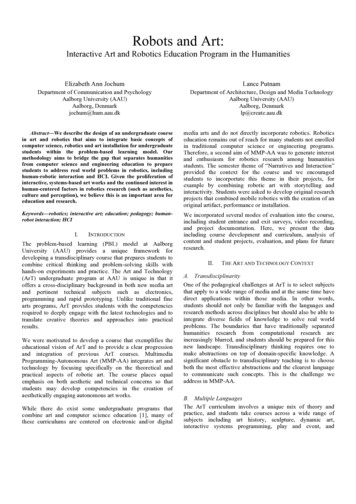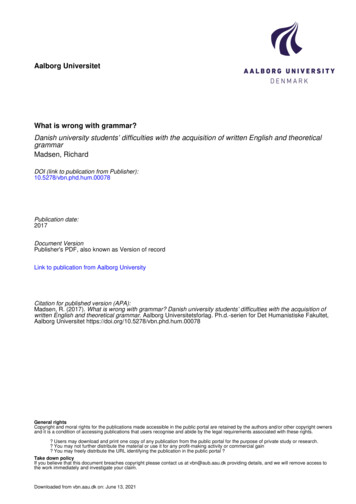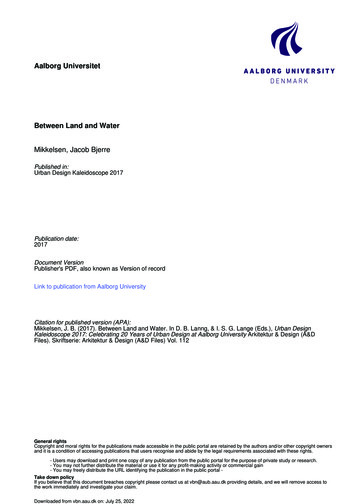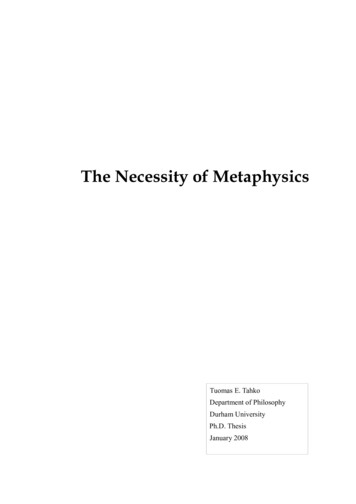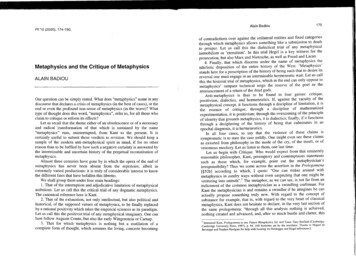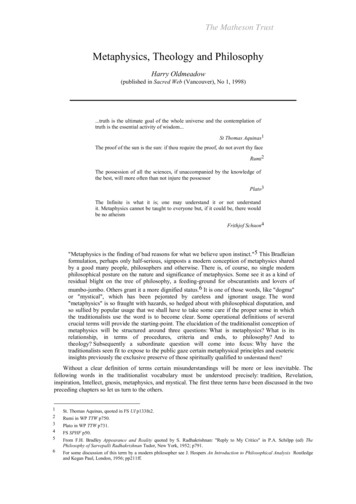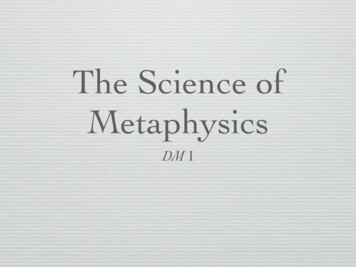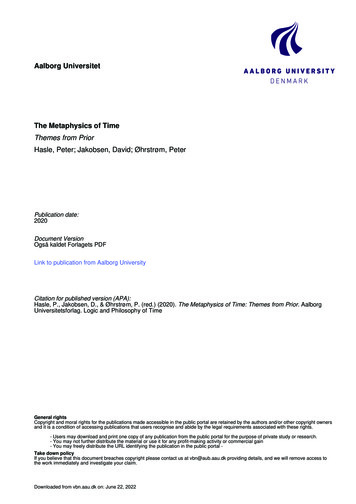
Transcription
Aalborg UniversitetThe Metaphysics of TimeThemes from PriorHasle, Peter; Jakobsen, David; Øhrstrøm, PeterPublication date:2020Document VersionOgså kaldet Forlagets PDFLink to publication from Aalborg UniversityCitation for published version (APA):Hasle, P., Jakobsen, D., & Øhrstrøm, P. (red.) (2020). The Metaphysics of Time: Themes from Prior. AalborgUniversitetsforlag. Logic and Philosophy of TimeGeneral rightsCopyright and moral rights for the publications made accessible in the public portal are retained by the authors and/or other copyright ownersand it is a condition of accessing publications that users recognise and abide by the legal requirements associated with these rights.- Users may download and print one copy of any publication from the public portal for the purpose of private study or research.- You may not further distribute the material or use it for any profit-making activity or commercial gain- You may freely distribute the URL identifying the publication in the public portal Take down policyIf you believe that this document breaches copyright please contact us at vbn@aub.aau.dk providing details, and we will remove access tothe work immediately and investigate your claim.Downloaded from vbn.aau.dk on: June 22, 2022
The Metaphysics of TimeLogic and Philosophy of Time, Vol. 4Per Hasle, David Jakobsen, and Peter Øhrstrøm (Eds.)
The Metaphysics of Time:Themes from PriorEdited by:Per Hasle, David Jakobsen andPeter ØhrstrømLogic and Philosophy of Time, Volume 4
The Metaphysics of Time: Themes from Prior Logic andPhilosophy of Time, Volume 4Edited by Per Hasle, David Jakobsen & Peter ØhrstrømSeries editors: Per Hasle, Patrick Blackburn & PeterØhrstrøm1st OA Edition The authors and Aalborg University Press, 2020Copy editing and interior design: Fatima SabirCover design: akila by Kirsten Bach LarsenPhoto on front cover: Mary Prior, courtesy of Martin PriorSet with the TeX Gyre Pagella & TeX Gyre Heros fontsISBN: 978-87-7210-724-0ISSN: 2596-4372This book is financially supported by the Danish Councilfor Independent Research Culture and CommunicatioPublished by:Aalborg University PressKroghstræde 3DK – 9220 Aalborg ØPhone: 45 99407140aauf@forlag.aau.dkforlag.aau.dk
Table of ContentsPrefacePer Hasle, David Jakobsen & Peter Øhrstrøm7From A-time to B-time: Prior’s journey there and back againPeter Øhrstrøm13The Public Prior: A.N. Prior as (relocated 17th & 18th century)Public Intellectual 1945-1952Mike Grimshaw25Dispelling the Freudian Specter: A.N. Prior's Discussion of Religionin 1943David Jakobsen63Prior and the “Logic of the Word of God”David Jakobsen & Hans Götzsche87Early Prior on the Nature of Modality: Debates with ŁukasiewiczAneta Markoska-Cubrinovska99Polish Roots of Meredith’s System of Modal LogicZuzana Rybaříková123The Beginnings of Hybrid Logic: Meredith, Prior and theContingent Constant nPer Hasle145Prior to PriorFlorian Fischer165
Letters between Mary and Arthur Prior in 1954: Topics onMetaphysics and TimeDavid Jakobsen, Peter Øhrstrøm & Martin Prior179Arthur Prior and Special Theory of Relativity: Two Standpoints fromthe Nachlass227Julie Lundbak KofodTime, Tense, and EternityWilliam Lane Craig249Legal Pardon, Tensed Time, and the Expiation of GuiltWilliam Lane Craig267Future Bias and PresentismSayid R. Bnefsi281Fatalism for PresentistsDavid P. Hunt299A Defence of Presentism Against the Rietdijk-Putnam-PenroseArgumentAtle Ottesen Søvik317Eternalism, Hybrid Models and Strong ChangeElton Marques329Living in a World of Possibilities: Real Possibility, Possible Worlds,and Branching TimeAntje Rumberg343Perspectival Semantics and the Open FutureCiro De Florio & Aldo Frigerio365History relativism as extreme assessment relativism:A note on Prior's OckhamismJacek Wawer387Remarks on Hybrid Modal Logic with Propositional QuantifiersPatrick Blackburn, Torben Braüner & Julie Lundbak Kofod401
Modeling Decision in a Temporal Context: Analysis of a FamousExample Suggested by Blaise PascalOla Hössjer427Counterfactuals and Irrelevant SemifactualsLars Gundersen455
6
PrefacePer HasleUniversity of Copenhagen, Denmarkper.hasle@hum.ku.dkDavid JakobsenAalborg University, Denmarkdavker@hum.aau.dkPeter ØhrstrømAalborg University, Denmarkpoe@hum.aau.dkThis is the fourth volume of the book series ”Logic and the Philosophyof Time”. As in earlier volumes, the main focus is on the beginningsas well as the further development of modern tense logic. However, inthe present volume most of the papers also consider basic metaphysicalquestions related to time, logic, and modality.In most cases, earlier versions of the papers in the volume have beenpresented at the conference “The Metaphysics of Time”, at Aalborg University, Denmark, 19st -21st March 2019. Following that event, the authors have been given the chance to improve their papers based on thediscussions at the conference and the suggestions in the peer reviews.As Peter Øhrstrøm argues in his paper “From A-time to B-time:Prior’s journey there and back again”, A.N. Prior’s life from his childhood to his death in 1969 can be conceived as a metaphysical journey.From the belief in free choice as a Methodist in his childhood, he asa teenager moved on to Calvinistic determinism and rejection of freewill, and at the age of 40 he introduced a brand new paradigm based7
on free choice, indeterminism and a tensed view of time. As argued byØhrstrøm, all the papers in the present volume can somehow be relatedto important topics and questions which Prior had to deal with on hislife-long, metaphysical journey.Prior was not only a highly qualified philosopher and an outstanding logician, but he also involved himself in a series of public debatesas a public philosopher. In his essay “The Public Prior: A.N. Prioras (relocated 17th & 18th century) Public Intellectual 1945-1952”, MikeGrimshaw argues that this activity can be viewed as a continuation ofhis public voice as religious journalist.There can be no doubt that Prior’s views on time, logic and modalityover the years were closely related to his religious and existential views.In his paper “Dispelling the Freudian Specter: A.N. Prior’s Discussion ofReligion in 1943”, David Jakobsen considers Prior’s metaphysical worldview and his correspondence with Karl Popper about relevant aspects offaith and unbelief. In their joint paper ‘On Prior’s “Logic of the Word ofGod”, David Jakobsen and Hans Götzsche consider Prior’s early paper‘The Analogy of Faith’, seeking out productive insights which it offersinto Prior’s view on logic.One of the things that made Prior so influential was his ability to cooperate with others. He maintained an extensive correspondence andwas quick to realize the potential of ideas suggested by his fellow logicians and philosophers. In many cases he would develop such ideasmuch further, whilst carefully acknowledging their original authors. Asargued in the paper “Early Prior on the Nature of Modality: Debateswith Łukasiewicz” by Aneta Markoska-Cubrinovska and Zuzana Rybaříková, Prior adopted the formalism and proof theory of Jan Łukasiewicz, although Prior disagreed with Łukasiewicz’ view on modality. Inhis development of so-called hybrid Prior was able to benefit from his cooperation with Carew Meredith, who introduced the notion of ‘worldpropositions’ in 1953. As pointed out in Per Hasle’s paper “The Beginnings of Hybrid Logic: Meredith, Prior and the Contingent Constant n”,Meredith’s 1953 note laid the earliest (albeit rudimentary) foundationof hybrid logic, and Prior later decisively improved this early notion ofworld propositions.Prior vigorously argued for a tensed view of time. However, he wasnot the first modern philosopher to do so. Other thinkers much earliermade similar points. As pointed out in Florian Fischer’s paper “Prior8
to Prior”, Moritz Schlick made the case for indispensable A-sentences25 years prior to Prior. Prior himself also referred to much earlier work(1908) by McTaggart, which in spite of imperfections contains important and fundamental observations in this respect. Such forerunnersnotwithstanding, Prior was the first philosopher to develop full-fledgedlogical systems based on the tensed view of time, and thus stands asthe founder not only of modern tense-logic but also of so-called hybridlogic.Prior found his tense-logical view of time challenged by relativisticphysics. In her paper “Arthur Prior and Special Theory of Relativity:Two Standpoints from the Nachlass “, Julie Lundbak Kofod exploresthe evolution of Prior’s views on the special theory of relativity. Shecompares and contrasts the views expressed in Prior’s early reactionswith his mature views, which were most fully expressed in Past, Presentand Future (1967).In their joint paper “Letters between Mary and Arthur Prior in 1954:Topics on Metaphysics and Time”, David Jakobsen, Peter Øhrstrøm andMartin Prior discuss correspondence between Mary and Arthur Priorand between Arthur Prior and J.J.C. Smart from 1954 on five topics: freedom, abstract entities, modal logic, religion and theology and finally thelogic of time. The paper argues that the logic of time was formulated inthe context of reflections on the first four of these.Clearly, Prior’s tensed view of time can still be analysed in a metaphysical and also religious manner. In his paper “Time, tense, and eternity”, W.L. Craig argues that if we are to understand divine eternity,we must first settle the question of the tenseless vs. tensed theory oftime. In his other paper in the volume “Legal pardon, tensed time, andthe expiation of guilt”, Craig deals with topics at the intersection of theology, philosophy of law, and philosophy of time. In particular, he explores the relation between legal pardon, tensed time, and the expiationof guilt.The following three papers all deal with conceptions of presentism.In his paper “Future Bias and Presentism”, Sayid R. Bnefsi has suggested an account of what some call “future bias”, according to whichthere is a preference for certain tensed truths properly relativized to thepresent. Furthermore, Bnefsi has demonstrated the compatibility of thisnotion with presentism.In his “Fatalism for Presentists”, David P. Hunt considers Prior’s9
view that presentism offers some obvious grounds for denying divineforeknowledge of future contingents. Hunt argues that this view is nottenable, or in the very least not cogent. On the other hand, he findsthat the recent foreknowledge debate has shown that Prior was right ininsisting that the idea of future contingent truth can well be challenged.In his paper “A defence of presentism against the Rietdijk-PutnamPenrose argument”, Atle Søvik considers the problems arising from thetheories of relativity with regard to presentism and touches upon theblock universe perspective. Søvik offers a defence of presentism againstsuch a line of argumentation.Elton Marques in his paper “Eternalism, hybrid models and strongchange” argues that eternalism in the block universe conception is compatible with change. In fact, Marques shows that what he calls ‘strongchange’ can in principle be introduced in an eternalistic model.The following three papers in the volume deal with problems relatedto the open future and branching time. In her paper “Living in a Worldof Possibilities: Real Possibility, Possible Worlds, and Branching Time”,Antje Rumberg introduces a notion of so-called real possibility. She argues that real possibilities—as temporal alternatives for actuality—aremost adequately represented in Prior’s theory of branching time.In their paper “Perspectival Semantics and the Open Future”, CiroDe Florio and Aldo Frigerio offer a perspectival temporal semantics, inwhich propositions are evaluated with respect to two indexes: the timeof evaluation and the time of the perspective. It turns out that this suggestion is very promising in relation to the foreknowledge problem.In his paper “History relativism as extreme assessment relativism: Anote on Prior’s Ockhamism”, Jacek Wawer introduces a doomsday extension of a branching model, and he proves that history-relative truthin any given model is equivalent to doomsday-relative truth in the extended model. It turns out that this equivalence holds in general only ifthe end of time is also, in a sense, beyond time.In their paper, “Some Remarks on Hybrid Modal Logic with Propositional Quantifiers”, Patrick Blackburn, Torben Braüner and Julie Lundbak Kofod have offered an conceptual and formal analysis of Prior’sinstant-propositions as well as other nominals in modern hybrid logic.They have shown that the two intuitions of instants suggested by Prior,the index view and the content view, correspond to two different interpretations of propositional quantifiers.10
In his paper “Modeling Decision in a Temporal Context: Analysisof a Famous Example Suggested by Blaise Pascal”, Ola Hössjer offersa study of the temporal aspects of the decision between two mutuallyexclusive alternatives available for an unknown period of time. The primary example is taken from Pascal, but Hössjer’s model is in fact a general approach to decision making in a temporal context.In his paper “Counterfactuals and Irrelevant Semifactuals”, LarsGundersen offers an analysis of some basic problems regarding the semantics of counterfactuals in terms of a notion of relevance. However,Gundersen shows that when we try to handle the notion of relevanceformally, we can easily get into trouble because of some very counterintuitive consequences. This calls for further research in order to come upwith a satisfactory notion of relevance.AcknowledgementsWe want to thank the persons who have contributed to the various partsof this book. We want to thank Dr. Martin Prior for the permission touse a drawing by his mother, Dr. Mary Prior, for the book cover. Furthermore, we also thank the Danish Council for Independent Research,for making this book possible.11
12
From A-time to B-time: Prior’sjourney there and back againPeter ØhrstrømAalborg University, Denmarkpoe@hum.aau.dkAbstractA.N. Prior developed his famous tense-logical paradigm during a periodof 15 years (1954-1969). However, it turns out that this work was doneunder the influence of a long struggle with scientific, philosophical andtheological problems regarding time and reality. During his childhood,it was generally taken for granted that we can to some extent make freechoices. However, when Prior was16 years old he wrote three booklets inwhich he rejected free-will and defended a kind of determinism relatedto the Calvinistic doctrine of predestination. He held on to this view foralmost two decades, although he went through periods of doubt duringwhich he felt that his world-view was challenged. In 1954 he finally leftdeterminism and embraced a tense-logical account of indeterminism, presentism and change. In terms of McTaggart’s A- and B-series this meansthat Prior as a teenager left the A-theoretical approach to time and realitywhich had dominated his childhood, and furthermore that after severalyears as a B-theorist he returned to a logically elaborated A-theory of timeand reality. Prior’s long metaphysical journey made it possible for him tosuggest a tense-logical paradigm that reaches far beyond his own modelsand theories.Keywords: A-time; B-time; determinism; free choice; Prior; Einstein; Bergson.13
1 IntroductionA.N. Prior (1914-69) contributed significantly to the development of themodern philosophy of time. In fact, his focus on the importance of thetenses has given rise to a new and powerful paradigm for the studyof time. Prior insisted on the reality of the distinction between past,present, and future, and he demonstrated how the temporal aspectsof reality can be treated formally in terms of tense-logic. He showedhow ideas of presentism, branching time and instant propositions canbe treated in terms of formal logic. Prior developed this famous tenselogical paradigm during a period of about 15 years (1954-69). However,recent research into the unpublished works of A.N. Prior makes it clearthat his remarkable tense-logical approach should be understood in thelight of a much longer struggle with scientific, metaphysical and theological questions concerning time and reality. Actually, this strugglebegan when he was a teenager!Prior was brought up in a Methodist home in which the importanceof free choice was emphasized. It was believed that the individual has tomake significant decisions for himself. The most crucial decision in life,of course, would have to do with conversion and becoming a Christianbeliever. In the Methodist Church, young people were strongly encouraged to make this crucial decision as a personal step into the Christianbelief. Prior presented his father as an Arminian, i.e., a defender of theview going back to the Dutch theologian Jacobus Arminius (1560–1609),according to whom man’s free-will is compatible with the doctrine ofGod’s sovereignty. According to this view a person can actually decidefreely to become a Christian. In this way, a conversion should be seenas a result of a free choice.Much later Mary Prior noted, looking back, that Arthur never hadany experience of a conversion of that kind and probably did not findthat he needed one (in personal communication). Anthony Kenny hasmade a similar point in his account of Prior’s rejection of his earlier denomination:He became dissatisfied with Methodism, finding its theology too unsystematic, and disliking its stress on the felt experience of conversion.(Kenny, p. 322)14
2 Rejection of the reality of free-will andbecomingAs a teenager Prior became a Calvinist and rejected that there couldever be any free decisions at all. It has recently been discovered thatPrior wrote three booklets during September and October in 1931 whenhe was just 16 years old. In these booklets he rejected his earlier beliefsin free-will and in becoming as a fundamental aspect of reality. Instead,he defended the view that the world is fixed and determined — a viewPrior related to the Calvinistic doctrine of predestination.With his booklets Prior apparently wanted to formulate an accountof his new world-view. At that time, he was preparing for his final examfrom Wairarapa High School in Masterton. He based his presentationon the knowledge he had obtained from literature, religion and science.This led him to writing the three booklets: Essays Literary, Essays Religious, and Essays Scientific. The first is in private possession in NewZealand, whereas the latter two have been donated to the Bodleian Library in Oxford as part of the Ann Prior Collection. Prior’s Essays haverecently been edited and published in (Jakobsen et al. 2020).In his essays Prior clearly tried to integrate religious and theological thought with current scientific and philosophical ideas. As noted byJack Copeland (2020) Prior, in his Essays Literary, even wanted to name“the greatest thinkers the world has known”. A project of this kind isobviously difficult, but Prior stated: “I have no hesitation in placing JESUS OF NAZARETH at the top of this list” (Jakobsen et al. 2020, p. 49).This clearly indicates that in the integration he was inclined to give theological and religious thinking a key role.Prior found that in integrating religious, philosophical and scientifiche thought the questions regarding the concept of time should be seenas very important. There are various notes and addenda attached to theEssays, and one of them is in fact entitled “Father Time”. In this note,dated 1.8.31, Prior wrote:Who shall contend with Time?” wrote Henry Kirke Whitein 1805, and to anyone with a pretence of education it mustbe obvious that the answer he intended was “Mach, Einstein,Jeans, Whitehead and Bergson.(“Father Time”, Prior’s Nachlass)15
Later in the same note Prior wrote:In my young days, when I was green in judgement, I usedto style myself a Bergsonian, but now, philosophically speaking, I prefer Einstein’s view, and try to paint on the tableau ofmy mind his picture of Space-Time as a vast void wreathedinto the strange and shadowy shapes of stars and atoms andlife and humankind.(“Father Time”, Prior’s Nachlass)According to the young Prior there are two important views of thetemporal reality: one based on change and tense (Bergson) and one referring to a fixed structure of Space-Time (Einstein). It should be mentioned that the two positions correspond to McTaggart’s A- and B-series,although Prior did not use this reference before P.T. Geach convincedhim that he should do so; see (Prior 1967, p. vi).It is obvious that Prior when writing in 1931 still found Bergson’sviews interesting:Even more importance is attached to Time by the greatFrench philosopher, Henri Louis Bergson, who holds that toargue about the nature of Time is futile, for Time is the onlything which exists, and Matter, Mind and Spirit are alike butaspects of it. Time, according to Bergson, is not just a sort ofabstract background against which events take place, but israther the one living Reality of which we are all but parts andaspects. For Bergson we are all like ripples and eddies on thestream of Time, a stream of “unceasing becoming, which preserves the past and creates the future.”(“Father Time”, Prior’s Nachlass)Here Prior quotes from H. Wildon Carr’s book on Bergson’s philosophy of time (Carr 1911, p. 15). According to this view, the proper understanding of time depends on change and becoming. It is not just “a sortof abstract background against which events take place”, but time is essential for life and reality as such. This also means that the tenses shouldbe taken into account. Prior presented his discussion of Bergson’s conception of time in Essays Religious, in which he made the criticism thatBergson fails to understand the importance of the permanent basis ofeverything:16
Reason teaches us that, though changes occur, they occur according to principles which do not change — that for all theever-changing appearances there must be some basis that ispermanent. But Bergson maintains that nothing is permanent, and indeed that Change is one name for the fundamental Reality. Another name for this Reality is Duration,or Time [ ](Jakobsen et al. 2020, p. 216)However, it seems that Prior’s main criticism of Bergson’s philosophy of time has to do with the notion of free will. Whereas Bergson insisted on some degree of human freedom as crucial feature of man, Priorsimply rejected this idea as being against the fundamental assumptionsof causality and determinism:This belief [ ] has been revived in recent years by HenriLouis Bergson, who applies the enticing term ‘creative’ toactions performed independent of any guiding motive orreason. What a lot of irresponsible maniacs we must be, tobe sure, if these people are right!(Jakobsen et al. 2020, p. 216)Prior’s earlier belief in human freedom probably has to do with hisreligious upbringing in Methodism and Arminianism. In Essays Religious he strongly argued against Arminianism. In fact, he wrote the following dedication in the beginning of this booklet: “Dedicated to myFather and other Arminians who will not agree with it.”According to Prior modern Arminians may be divided into twoschools (Øhrstrøm et al. 2000, p. 210):1. Those who hold that God’s control of the Universe is imperfect,and that Change plays a considerable part in Nature’s workings.2. Those who hold either that God does not exist or He is perpetually changing, or even that He is Himself Perpetual Change, andbelieve in what they call “creative freedom”.Prior mentioned Bergson as a representative of School 2, and in thebooklet Prior consequently rejected the Bergsonian beliefs in free-willand in change as a fundamental aspect of reality. However, it seems17
that his main reason for this was religious. He pointed out that “if Bergson and his followers are right in saying that the fundamental Reality isChange, the unchangeableness of God is also challenged” (Øhrstrøm etal. 2000, p. 218). Prior certainly had to oppose that view.Having rejected the Bergsonian and Arminian view of time, Priorargued in favour of scientific determinism quoting the following claimfrom Einstein:Everything is determined, the beginning as well as the end,by forces over which we have no control. It is determinedfor the insect as well as the star. Human beings, vegetablesand cosmic dust, we all dance to a mysterious tune intonedin the distance by an Invisible Piper.(Øhrstrøm et al. 2000, p. 200)Furthermore, Prior pointed out that according to Einstein events “donot happen — we simply come across them” (Øhrstrøm et al. 2000,p. 240). In his note dated 1.8.1931 and entitled “Father Time” Prior maintained that Einstein was a follower of Ernst Mach, who had “reducedthe concept of Time to a kind of meaningless figment of the imagination based on the observed succession of events”.Prior found a similar account of determinism (and maybe even somekind of Predestination) in the works of Shelley. Prior quoted Shelley:We live and move and think; but we are not the arbiters ofevery motion of our own complicated nature; we are not themasters of our own imagination and moods of mental being.There is a Power by which we are surrounded, like the atmosphere in which some motionless lyre is suspended, whichvisits with its breath our silent chords at will.(Øhrstrøm et al. 2000, p. 137)In this way Prior pointed out that both Shelley and Einstein – aswell as many others – have spoken convincingly in favour of a determinism fully consistent with Calvinistic predestination. Such accountsleave no room for human freedom. Furthermore, this view means thattime should be conceived as something fixed. It means that time is infact an “abstract background against which events take place” (to usethe expression Bergson strongly opposed). On this Einsteinian view18
the “passage of time” is not something real, but “just one of our manydelusive sense-impressions” and the distinction between past and future is a mere “convention based on light-signals.” (Øhrstrøm et al.2000, p. 241).In his essays from 1931 Prior argued in favour of such an Einsteinianview of time and reality. In his opinion Einsteinian determinism andCalvinistic predestination should be understood as two approaches tothe same world-view according which time is an eternal structure thatleaves no room neither for free choice nor for becoming and change. Itis evident from his letters to Ursula Bethell (Grimshaw 2018), that heremained dedicated to Calvinistic predestination and determinism during the 1930s. Apparently, he even kept supporting this view most ofthe time during the 1940s. However, his world-view was challengedseveral times during the 1940’s. As Mary Prior remembered there wassomething about his view that did not please him:[ ] it is true that Arthur was preoccupied by the problemof free will. At first he saw it in a semi-theological context. Ihave never felt quite sure how seriously Arthur really tookthe Calvinism which intellectually attracted him. It was rigorous and logical, unlike the Methodism of his childhood.But its God lacked humanity. I think sometimes he entertained Calvinism in its various forms rather than quite believing it. He was very aware of the dilemmas it posed. Perhaps his failure to resolve them was a reason why despite somuch preparation the book on Scottish Theology never cameto anything. In his later work I think he was prepared to gowhere logic led him, but the idea of the future as open tochoice, where the past and present were not, may also havehad deeper emotional attractions. But here I speculate.(Mary Prior, 1997; quoted form (Prior 2003, pp. 301-302))3 Return to a belief in the reality of tenses andfree choicePrior’s metaphysical journey eventually resulted in the precise formulation of his tense-logical views presented for the very first time at theSecond Philosophical Congress, held at Victoria University Wellington,19
New Zealand, on the 27th August, 1954. It is not clear what made himchange his mind. However, his interest in ethics and deontic logic mighthave made him rethink his view on free choice and reality, see (Jakobsen et al.; in this volume).Prior was not the first to formulate a logic of time. As mentionedin (Øhrstrøm and Hasle 2019) an account of a logic of time had earlier suggested by Jerzy Łoś, which was in fact recognized by Prior himself. Even the emphasis on the importance of tenses had been defendedby Moritz Schlick two decades before Prior’s findings; see (Fischer; inthis volume). However, as pointed out by Fischer Prior’s and Schlick’scontexts differed a lot. Prior saw his tense-logic as a re-discovery ofmedieval logic, and his approach was very systematical and general.Furthermore, his ideas were presented in terms of a very powerful formalism. This still makes it reasonable to present Prior as the father ofmodern tense-logic.There can be no doubt that Prior in first presentation found a lot ofinspiration from modal logic and his studies of Polish Logic; see(Markoska-Cubrinovska; Rybaříková; this volume). In his further development of tense-logic he was clearly able to benefit from the closeco-operation with a number of fellow logicians, such as Carew Meredith; see (Hasle; this volume).Prior formulated his new tense-logical position in an undated paper,“Some Free Thinking about Time”, which he never published:So far, then, as I have anything that you could call a philosophical creed, its first article is this: I believe in the realityof the distinction between past, present, and future. I believe that what we see as a progress of events is a progressof events, a coming to pass of one thing after another, andnot just a timeless tapestry with everything stuck there forgood and all [ ]This belief, or prejudice of mine, is bound up with a beliefin real freedom. One of the big differences between the pastand the future is that once something has beco
The Metaphysics of Time Logic and Philosophy of Time, Vol. 4. TheMetaphysicsofTime: ThemesfromPrior Editedby: PerHasle,DavidJakobsenand PeterØhrstrøm LogicandPhilosophyofTime,Volume4. . schools(Øhrstrømetal. 2000,p.210): 1. Those who hold that God's control of the Universe is imperfect,


